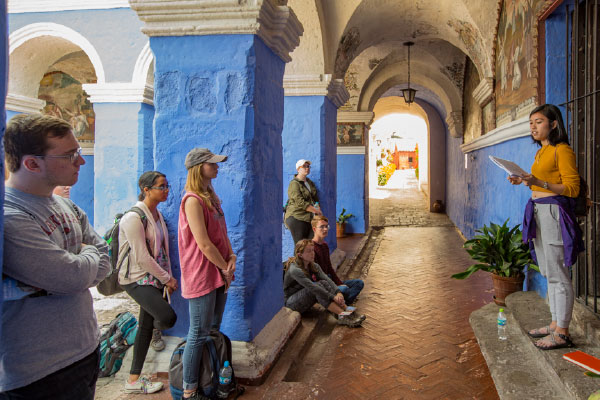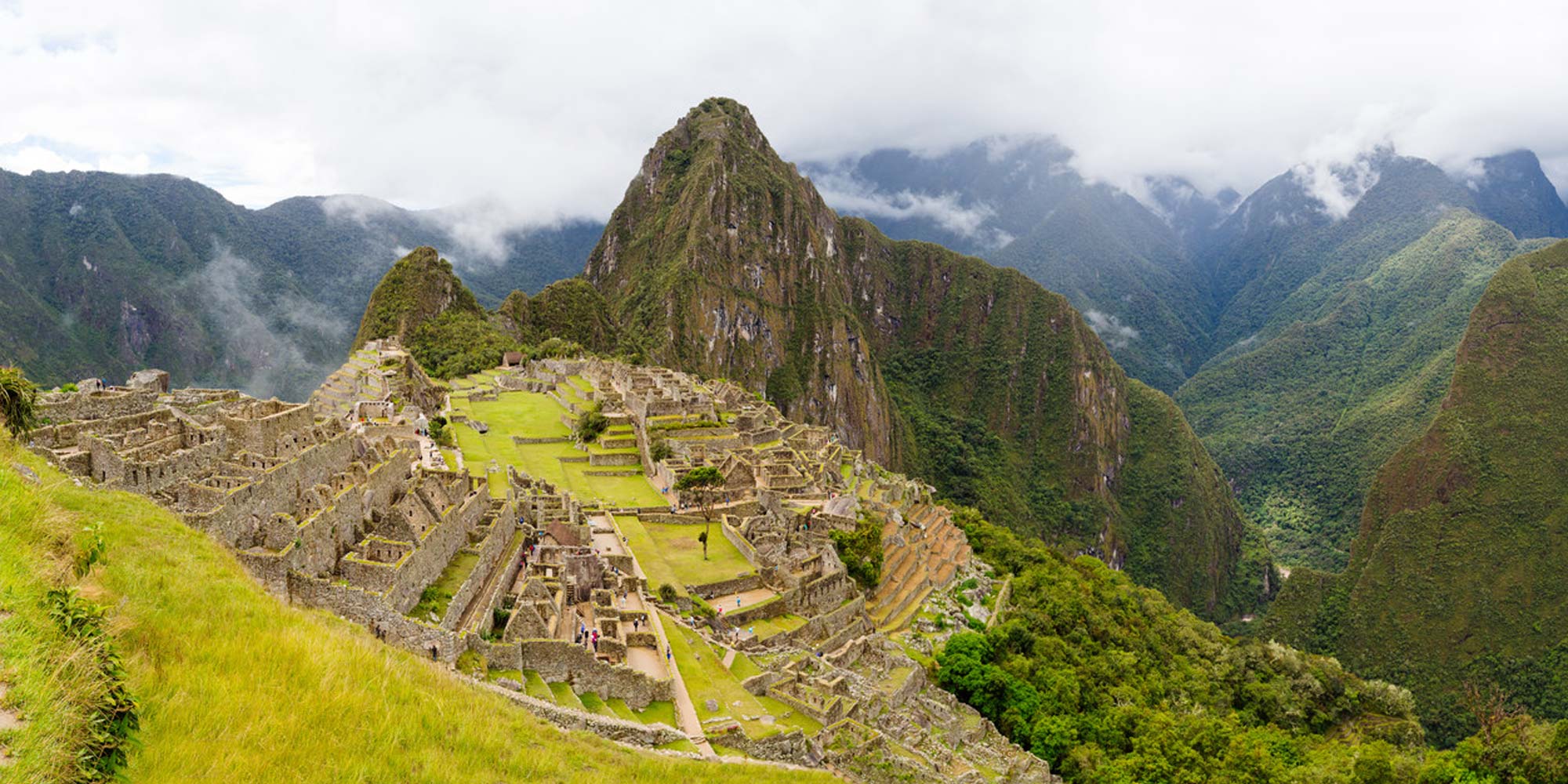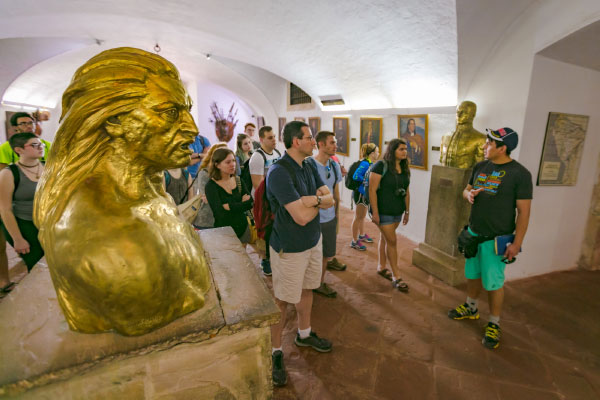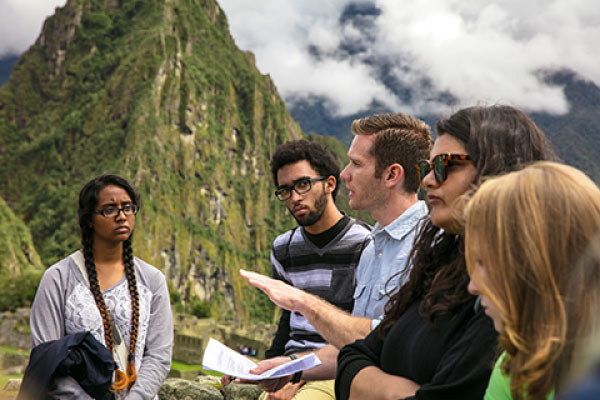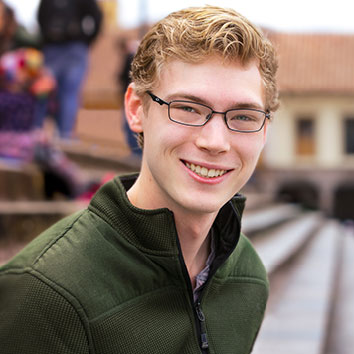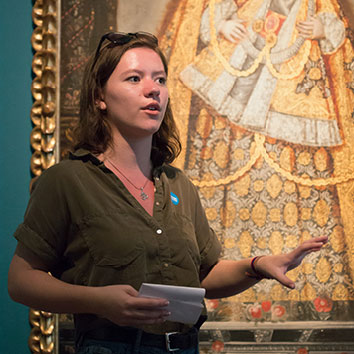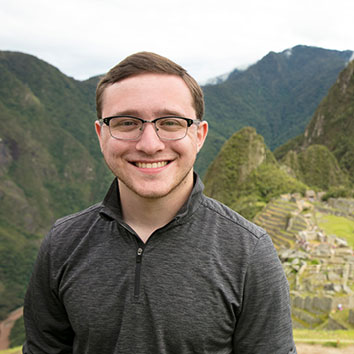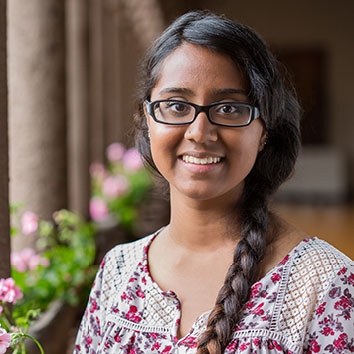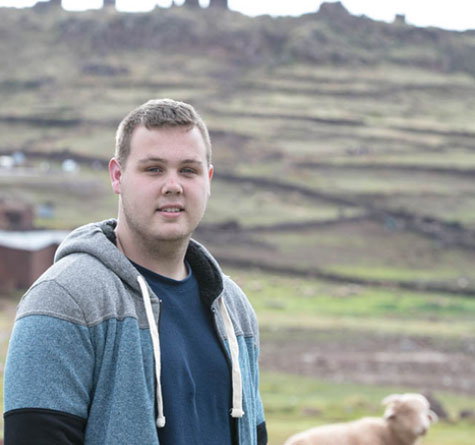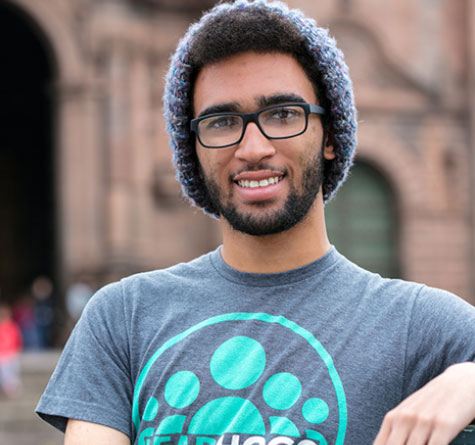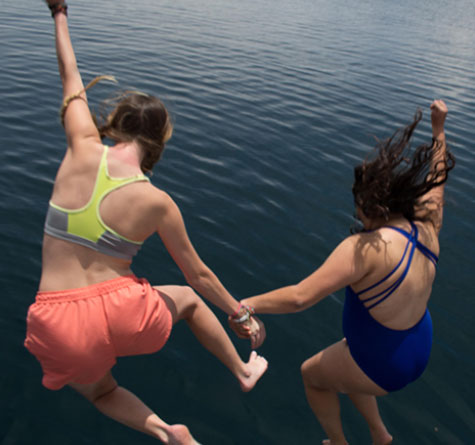Navigating Tourism – Isla Amantaní, Lake Titicaca

The students tour pristine Lake Titicaca in a reed boat. Shown, l-r: Dennis Mitchell,
Dani Carson, Meg Martinez, Anthony Azzun, Katie Gerth, Rashi Ghosh, Linh Luu, Dylan
DeLay (partly obscured), Cami Conroy, Rachel Lindsey and Summer Webers.
Our speedboat skims across the clear blue waters of Lake Titicaca, purported birthplace
of the first Inca, Manco Cápac. Dotted with islands both natural and manmade from
reeds, the lake shelters indigenous peoples whose traditional way of life centers
around fishing, farming, weaving – and now, tourism.
When we arrive at Isla Amantaní, our hostess Valentina and her L’Ampayuni kinswomen
lay necklaces of kantuta, the national flower of Peru, around our necks and escort us up the hill to their
home, a coral-colored adobe compound, lush with brightly colored flowers, that has
been expanded to accommodate groups like ours.
It’s student Katie Gerth’s turn to present, and she reports on the impact of tourism
on the indigenous populations who make their home on Lake Titicaca. There are positives:
“Tourism is Peru’s second-largest industry, and Peru itself has the second-highest
growth rate in Latin America, probably thanks in large part to tourism,” Katie says.
She points to economic growth, education and cultural survival as positive benefits
for the people who live on these islands at a time when global assimilation threatens.
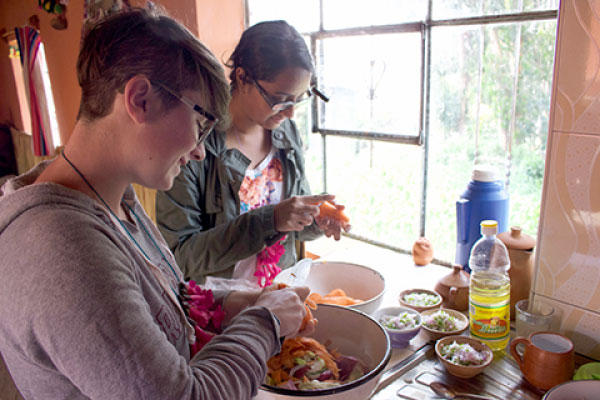
Cami Conroy and Rashi Ghosh lend a hand in the kitchen at Isla Amantaní.
But there are drawbacks. The locals own their land, but anti-monopoly laws passed
in 1991 gave tourist agencies a foothold to control the experience – first through
boat transportation to the islands, and now management of scheduling, meals and homestays.
“To gain back control one would think that the islanders should just become the tour
guides, but this is difficult, because becoming a tour guide requires a four-year
degree in tourism.” Cultural and economic hurdles make that degree a tall order, Katie
adds.
We come away from Katie’s presentation a bit wary but are soon embraced in preparations
for a spectacular midday meal. Katie and another student, Rashi Ghosh, volunteer to
help and practice their Spanish while chopping vegetables for soup in the tiny kitchen.
The major bustle takes place outdoors, where local men shovel hot stones from a large
campfire into two earthen pits lined with eucalyptus leaves. Our hosts are treating
us to a special celebratory meal of Pachamanca (“earth pot”), and quite literally,
the earth cradles searing hot stones that cook chicken marinated in herbs and garlic
and wrapped in oiled paper. Bright purple, gold and russet potatoes are also nestled
into the steaming hot cavity. The feast is rounded out with sopa de trigo, a wheat and vegetable soup; steamed broccoli, onions, carrots and choclos, jumbo-sized Peruvian corn; and a spicy aji salsa that we slather on the chicken. “I’d say this is the best meal we’ve had so
far in Peru – including fine dining,” Austin opines, and all of us agree.
Peru has the second-highest growth rate in Latin America, probably thanks in large
part to tourism – but there are drawbacks.
Austin and several other athletes among us work off lunch with a pick-up game of soccer
with two local boys on a playing field well up the mountain, where fetching the ball
provides as much exercise as scoring goals. Then the whole group, led by Valentina’s
brother Jacinto, decide to climb 1,000 feet to one of two shrines on the island, this
one dedicated to Pachatata (“earth father”).
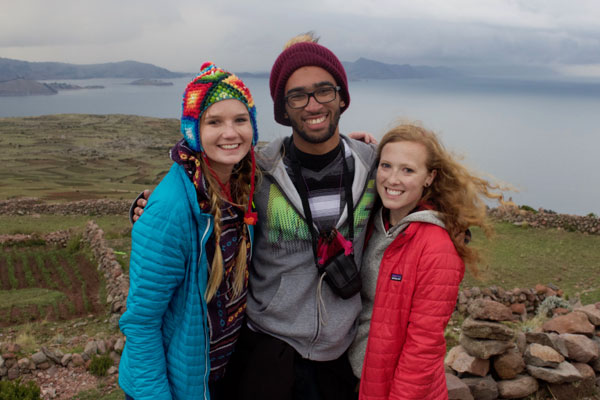
Summer Webers, Anthony Azzun and Becca Gilliland take in the views from the mountaintop
shrine dedicated to Pachatata ("earth father").
It’s a tough climb, at high altitude. Austin and our host take the lead, chatting
in Spanish. We stop frequently to catch our breath and wait for stragglers to catch
up. At one such stop, Jacinto produces a bag of coca leaves. We are invited to take
three leaves each and chew on them, and following this ritual rooted in Incan times,
the climb seems doable. We make it to the top, pose for pictures, circle the shrine
three times for good luck, then beat the rain storm down the mountain.
After dinner, our island idyll takes a turn towards full-on tourism. Our guide encourages
us to don native dress – the men pull on ponchos and chullos, knitted caps with earflaps that keep them warm, a plus given that rain has brought
a steep drop in temperatures. We women are dressed in embroidered blouses and polleras, heavy wool skirts, over our jeans, and Valentina cinches the skirts tight with chumpis, intricately woven belts. Then we head to a dance in a nearby community hall, where
a band plays traditional tunes and locals show up to drink beer and dance with us.
I’m uncomfortable wearing the costume and later learn that others had reservations
about the experience as well.
The next day, Austin summarizes the dance as a “forced fiesta” cooked up by the tour
guide, but this experience becomes a defining teaching moment in the course.
Professors Hare and Austin want to cut out the trip to Amantaní altogether on the
next trip to Peru, but the students describe the experience as perspective changing.
“This was one of our only chances to actually engage with indigenous people on this
trip,” Katie points out. “I learned what it is to be a tourist – this was important
for us to see,” Rachel Lindsey says.
“We find ourselves – an honors class – in this complicated position of how to experience
these moments,” Austin says. “And that’s what I love about this class, because these
students are cognizant of this, and we’re talking about it constantly. They’re questioning,
‘what does identity mean in these contexts?’”
